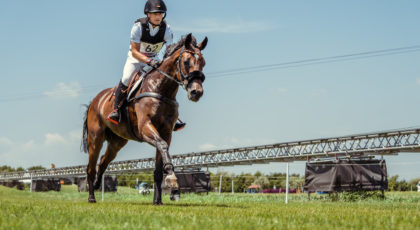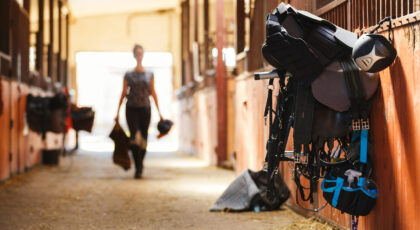One evening, I was cleaning stalls when a friend, who is a nurse, stopped by the barn. She walked to the stall where I was stuffing a haynet and, without saying hello, asked, “Why aren’t you wearing a dust mask?”
I laughed. “Barns are dusty, right?”
“Look at all the dust hanging in the air,” she said. “Do you want to get COPD? How about lung cancer?”
Now she had my attention.
You know that dust, mold, and allergens from hay and bedding can lead to heaves and inflammatory airway disease in your horses, but have you ever stopped to think what all those airborne particles are doing to your lungs?
Equine workers and the risk of respiratory problems
When we think of horses, we tend to imagine the outdoors and fresh air, but much of horse work takes place inside the barn where arena footing, stall bedding, and hay create a great deal of dust.
In 2006, a survey of North American riding instructors showed that instructors who did not smoke were 44% more likely to develop bronchitis symptoms if they worked primarily in an indoor arena as opposed to an outdoor arena. Instructors who smoked were 67% more likely to develop symptoms of bronchitis.
Another study from 2002 looked at equine grooms and found that constant exposure to horse hair resulted in higher rates of asthma and decreased lung function.
More recently in 2019, a study in Ireland followed one self-employed horse farm owner as the owner cared for and trained 45 horses. The study concluded that the owner had an increased risk of lung cancer due to inhaling respirable crystalline silica from commonly used arena footings such as sand and sand mixed with shredded carpet.
The basics of dust masks
If dust is the problem, it follows that masks are the solution. In general, there are two types of what many people tend to consider “dust masks.”
First, there’s the “nuisance dust mask,” which is made of thin, opaque filter paper and attaches around your head with one elastic strap. This mask filters out only larger particulate matter.

The Agricultural Safety and Health eXtension Community of Practice, a collaborative between universities, industry, and government to provide user-friendly information, explains that the nuisance dust mask should only be worn if you have “no prior respiratory impairment and are completing a short-term task involving non-toxic dust, such as sweeping the floor of a garage or shop.” The nuisance dust mask is not certified by the National Institute of Occupational Safety and Health (NIOSH).
The second type of so-called dust mask is known as a disposable particulate respirator. This type of mask attaches around your head with two elastic straps, has a filter made of fibrous material that traps particles as you breathe, and is certified by NIOSH.

These certifications will be clearly labeled on the box (and possibly the respirator) and will tell you exactly what the respirator is designed for and how much protection it provides. For example, a respirator might filter small particulate matter, but not toxic vapors.
Two notes of caution:
- If you have asthma, cardiovascular problems, or any respiratory conditions, check with your doctor before using a disposable particulate respirator. These respirators place additional stress on your breathing because your own breath forces the air through the filter. (Some respirators have an exhaust valve that makes exhaling easier.)
- Read the instructions. Improper use of the respirator will not protect you and might make your exposure to particulate matter worse than if you wore no protection at all.
For more detailed information on masks and respirators and the types of pollutants they filter go to the National Ag Safety Database and NIOSH.
But dust masks are uncomfortable
Especially on hot, humid summer days. And if you wear glasses, like I do, your breath fogs up the lenses. I also felt ridiculous wearing a dust mask. I didn’t know any farmers who wore them, why should I?
COPD and lung cancer. That’s why.
I began by wearing the nuisance dust mask. Although it doesn’t filter out small particles, it isn’t as restrictive as the disposable particulate respirator and helped me get used to having a mask on my face. I also figured out how to wear my glasses—pushed forward on the mask so the lenses won’t fog.
Once I was comfortable wearing the nuisance dust mask, I switched to a disposable particulate respirator, which I now wear every time I clean stalls, handle hay, groom horses, or put on and take off sheets and blankets. I throw out the respirator every two to four days. I often stop for a moment to look at how filthy the respirator is. All that dust was once going into my lungs.
Other dust control techniques
Dust masks and respirators won’t solve every situation, of course. Wearing one while giving a lesson, for example, is going to be difficult. Nor are there disposable masks for horses. Minimizing the amount of dust in the air is equally important.
- Wet down the riding arena. Although the 2006 survey of riding instructors did not show that the use of a dust suppression agent (primarily water) on an indoor arena reduced the rates of bronchitis, in the Ireland study watering down the indoor arena significantly lowered the concentrations of respirable crystalline silica in the air.
- Open the doors to the indoor arena
- Use the outdoor arena as much as possible
- Wet down the hay
- Keep the barn and stall windows open.
Remember, as a horse trainer, instructor, and farm owner you’re going to be breathing particulate matter over 20, 30, or even 40 years. Protect your lungs so you can keep riding and doing the work you love.
About the Author
Nancy Hoffmann manages a horse farm in Maryland and focuses on caring for senior and retired horses. Visit her website at www.mistybluefarm.net.


 December 2, 2019
December 2, 2019 























